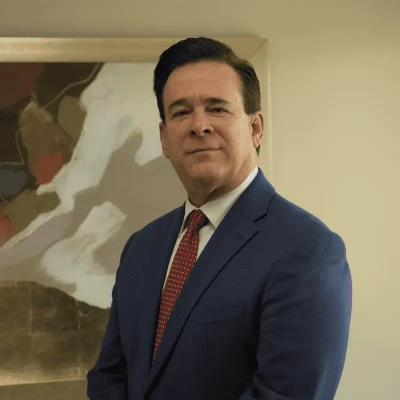How to Improve Customer Retention and Foster Long-Term Loyalty
Customer retention and long-term loyalty require strategic approaches backed by proven methods. This comprehensive guide shares insights from industry experts on building meaningful relationships through personalized experiences, community engagement, and consistent service quality. Discover actionable strategies to transform transactions into lasting partnerships that drive sustainable business growth.
Create Elevated Personal Luxury Experiences
One of the most effective ways we've built long-term loyalty is by creating a luxury experience that feels just as good as the results look. From the moment a client books to the time they leave our clinic, every detail; the communication, the space, the way we explain treatments, is designed to feel elevated, personal, and effortless. We want them to feel seen, cared for, and completely confident that their time is valued; that is what builds loyalty!

Build Value Through Dedicated Membership Programs
One effective strategy I've implemented for customer retention is creating a dedicated membership program designed to encourage regular engagement. Our program provides special benefits that make customers feel valued and recognized for their loyalty, which has contributed significantly to our improved retention metrics. This approach has been instrumental in transforming one-time buyers into repeat customers by giving them compelling reasons to continue choosing our products or services over competitors.

Transform Transactions Into Growth Conversations
One of the most effective strategies I've used to improve customer retention is what I call the "continuity loop"—building an intentional feedback and value cycle that keeps customers feeling seen, supported, and one step ahead. Instead of treating retention as a post-sale effort, we start nurturing it from the first interaction.
The key shift was moving from transactional communication to transformational engagement. After every purchase or project, we implemented a structured feedback loop that wasn't just about satisfaction scores—it was about progress. We'd ask, "What changed for you since working with us?" and use that insight to guide our next touchpoint. Then, we'd proactively share quick wins, personal recommendations, or industry updates tailored to their goals. It turned every follow-up into a conversation about growth, not just service.
What made this approach work long term is that it created a rhythm of genuine care. Customers didn't just feel like they were buying from us—they felt like we were growing with them. Over time, this loop built emotional equity, not just brand loyalty. Retention rates improved by over 30%, but more importantly, referrals became our top acquisition channel.
Here's the truth: retention isn't about locking customers in—it's about making them want to stay. When people feel understood, they stop looking for alternatives. That's the power of connection at scale.
Foster Human Connection Beyond Business Transactions
One of the most efficient things we did at Cafely to encourage our customers to return wasn't just through creative marketing campaigns or systems of loyalty points, but simply by being human. In the early days, I personally replied to customers' emails myself, sharing stories about how our coffee is grown in Vietnam or how it prompted me to share photographs of my last visit with the farmers. Sometimes, I simply spoke about how I drink my coffee in the mornings when things get a little out of control. What I had not anticipated was the reaction from people. They didn't simply reply and thank me for the story, but shared their own coffee moments too!
That is when I realized that loyalty is not built upon transactions but upon connection. Accordingly, everything we do, from our mail shots, social media posts, even down to packaging, is designed to convey warmth and a sense of connection. For when customers feel seen and connected, they do not only buy; they stay.

Combine Loyalty Programs With Automated Reminders
One of our most effective retention strategies at Forge Digital Marketing is combining Smile.io loyalty programs with Klaviyo email and SMS marketing. We make it effortless for customers to sign up for loyalty rewards, then use automation to keep that engagement going.
When a customer passes their predicted next purchase date, Klaviyo automatically reminds them of their unused points or upcoming rewards — a fun little nudge that almost always drives a return visit.
It's a seamless blend of psychology and personalization. People love feeling rewarded, and when you remind them that value is waiting for them, they come back. Every time.
Offer Tiered Volume Discounts With Faster Turnaround
We had this issue with agencies buying our SEO services. They'd hit a certain spending level and just stop, like they were hesitant to go bigger. So we tried something pretty straightforward. We created tiers based on volume. Order more, you get a better discount and we turn the work around faster. That one change made a huge difference. Agencies started booking larger projects and sticking around for the long haul. It wasn't just about the discount, I think it was the faster turnaround that showed them we valued their bigger commitment. You could probably do the same. Just dig into your client data and see who's on the edge of ordering more. A little nudge like that might be all they need.

Share Authentic Client Results Not Marketing Pitches
At Plasthetix, we spent months trying to figure out how to get our healthcare clients to stick around. We tried all the usual retention plays, but nothing really moved the needle. Then we started sharing actual client results online, not the polished marketing stuff but the real stories. Like a short write-up about how a surgeon cut her prep time by 15 minutes with our product, or a quick video from a clinic manager talking about the hours his staff saved each week. That's when things changed. The same doctors started calling us back, not with questions but with new orders. They started referring us to colleagues at other hospitals. It turns out they didn't need another sales pitch. They just wanted to see proof that it worked for someone just like them.
Create Community Ownership Through Visible Feedback
Retention doesn't arise from confinement; it comes from creating a sense of belonging. One of our most effective ongoing strategies at Legacy Online School is building true community among families, not just students, but jump-starting and maintaining relationships across families, too.
When we initially opened, we recognized most parents liked enrolling, but still held some doubt, taking on a "is this really going to be best" perspective. So we created virtual parent groups, where families can talk, share, ask questions, and share experiences together. I saw something unprecedented happen. Based on some tiny and simple opportunities, I had parents that might have been on the fence, become our biggest defenders, encouraging others to hold the course, because they had lived it.
I also believe it is valuable for us to keep the feedback loop short, and visible. For example, if a parent suggests something on our platform, I don't just put it in a file for later. Instead, we actually follow up with them, show them the change (improvement), and thank them once again for being a part of shaping our school together. It is a one small but meaningful process that creates change.
The result is an organic sense of loyalty. Families stay because they are not just purchasing a service; they are part of something they participated in creating. Retention becomes less about strategy and more about an authentic relationship when individuals feel ownership.

Develop Features That Become Daily Workflows
Our best strategy for improving customer retention has been focusing on building features that people actually use every day. Retention doesn't come from complexity — it comes from consistency and relevance. Every new feature we build at Zors has to connect meaningfully to the daily workflows of sales, operations, and legal teams within a franchise system.
We look for ways to bridge those functions — for example, a compliance milestone that automatically updates in a sales dashboard, or a document tracker that supports both franchise development and legal review. Those connections turn Zors from a single-use tool into an essential hub.
The result is that customers don't just log in when they have to — they rely on Zors to run their day. When your product becomes part of your customer's routine, loyalty follows naturally.

Ensure System Reliability Through Proactive Monitoring
System robustness and support requires proactive management to achieve success. The implementation of Prometheus and Grafana for health-monitoring dashboards with automated alerts and Application Insights exception tracking within our enterprise analytics platform delivered system transparency which reduced downtime and established client trust in our continuous monitoring. Users develop long-term loyalty when they no longer need to question system reliability because the system functions without interruption.
Our team prevents excessive system complexity from developing. We maintain a stable technology stack by selecting .NET Core and Angular for specific needs and perform upgrades only when new features provide tangible advantages. The clients maintain their loyalty because we refrain from performing unnecessary system rewrites based on current trends.

Craft Personalized Post-Purchase Relationship Journeys
One of the best practices that I have used to promote customer retention is the building of a personalized post-purchase experience that continues the relationship past the point of sale.
For example, after a customer buys a product, we start an automated but personalized follow-up process — recommendation engines, "pro tips" on how to get the most from the product, and early access to upcoming launches. This shifts the conversation from transactional to relational.
The trick is to make customers feel noticed, cared for, and rewarded:
- Notice — by behavior- or preference-driven relevant conversation.
- Care for — with helpful, informative content instead of persistent sales incentives.
- Reward — with loyalty rewards, insider information, or praise for repeated interaction.
Repeat buys are only the beginning; this approach also builds emotional engagement — the foundation of true long-term loyalty.

Pair Digital Rewards With Unexpected Store Interactions
When we were expanding Dirty Dough, we learned something fast. The loyalty app was supposed to be the hook, and it worked okay. But what really got people to come back was pairing it with small, unexpected things in the store. After we launched the rewards program, we started handing out free, warm samples to anyone who looked like they were debating the menu. Suddenly, the same faces were showing up three times a week. They'd mention the app, but they'd also mention the cookie we gave them last time. That's how the word-of-mouth started. It wasn't a campaign; it was just people telling their friends about the place that gave them a free cookie on a Tuesday. People remember that kind of thing. And they come back.
Turn User Feedback Into Rapid Product Improvements
Retention doesn't come from perks — it comes from progress. Our best customers stay because they see the product getting sharper around their pain points every month. We turn every support ticket into a feature request and close the loop fast. That's what builds loyalty: momentum. When users see that their feedback turns into product velocity, they stop thinking of you as a vendor and start thinking of you as an advantage.

Establish Regular Data-Driven Health Accountability Check-ins
We introduced quarterly "health accountability check-ins" that combine data-driven insights with personal interaction. Each session reviews a member's health trends—lab results, visit frequency, and lifestyle goals—framed around progress rather than problems. This structure shifts care from reactive treatment to continuous partnership, reinforcing that their membership delivers measurable, ongoing value.
The approach strengthened loyalty because patients felt seen beyond appointments. Retention rates rose by nearly 25% within six months, and referral activity increased organically. Consistent, human-centered communication proved more powerful than any discount or incentive. Loyalty grew not from marketing, but from making each member feel part of their own health journey, guided—not managed—by our care team.

Commit To Free Maintenance Beyond Contract Terms
Customer retention in the roofing business isn't about loyalty programs; it's about making a commitment that lasts longer than the storm season. Our most effective strategy for building long-term loyalty is simple: We own the attic and the gutters after the job is done.
Most roofers disappear the moment the final check clears, and that creates customer anxiety. Our strategy is built on eliminating that anxiety. When we finish a roof, we commit to two free maintenance checks over the next five years. We don't wait for the client to call us with a leak; we call them.
The implementation is hands-on and straightforward. Three years after the install, we send a crew member out to check the attic for ventilation issues, clear any debris from the gutters, and inspect the flashing for wear. We treat it as part of our original warranty commitment, even if it technically isn't. We send the client a short, simple report saying, "Your roof is looking good, and we cleaned your gutters for you."
This simple act of coming back long after the money has been spent is what builds real loyalty. The client sees that we are committed to their long-term security, not just our short-term paycheck. They refer us because they know we will actually answer the phone five years from now. They aren't just coming back for "more roofing"; they are coming back for peace of mind. The best way to build long-term loyalty is to be a person who is committed to a simple, hands-on solution that proves you will stand by your work.
Deliver High-Impact Fixes During First Month
Instead of waiting months to show value, I made it a point to identify one small but high-impact fix in the first 30 days—whether that was tightening email security, speeding up logins, or eliminating a nagging downtime issue. I recall a client whose staff had endured painfully slow VPN access for years; we optimized it within the first week. That quick win set the tone for the entire relationship—they immediately saw we could make their lives easier.
The way I measured its impact was straightforward: renewal conversations became smoother, and referrals began to come in without my prompting. Clients would say, "They solved something we thought we'd just have to live with." That taught me retention isn't always about the long-term roadmap—it's about building trust right away by proving you can deliver meaningful results quickly. That early momentum keeps customers engaged and far more likely to stick around.

Connect Alumni With Students Through Meaningful Mentorship
We had a problem with membership renewals, so we tried something different. We started pairing up alumni with current students for mentorship, so the community wouldn't just disappear after a course ended. This gave the alumni a way to give back that wasn't just getting another renewal email from us. Suddenly they were sharing job advice, helping a current student with a tough project. One alum told me he felt more connected than ever. It makes sense. When people feel like they belong, they stick around. Our renewal rate is up about 15 percent now.

Celebrate Customer Milestones With Personal Outreach
One strategy that has proven effective for improving customer retention is implementing technology-powered personal check-ins at key customer milestones. Our system automatically identifies important achievements in the customer journey, such as publishing their first workflow or inviting team members, then triggers both automated congratulatory messages and personal outreach from our team. This approach allows us to scale personalized attention while ensuring customers feel genuinely valued throughout their experience with our product. The combination of technology and human connection has significantly strengthened our customer relationships and improved long-term loyalty.

Make Clients Collaborators Through Transparent Dashboards
One of the most effective ways I've found to improve customer retention is to make our clients feel like collaborators, not just customers. At Ranked, we do this by giving brands and creators shared visibility into performance through the Ranked 2.0 campaign dashboard.
When partners can see real-time engagement, creator results, and ROI data, they don't have to wait for a report to know what's working. That transparency builds trust and gives them a sense of control. I've seen that when people feel part of the process, they naturally stay invested in it.
Beyond the technology, I stay focused on consistency, checking in after campaigns, listening to feedback, and celebrating wins with our partners. Loyalty doesn't come from contracts; it comes from genuine collaboration and shared success.
Match Clients With Consistent Care Providers
One of the most effective strategies we've implemented to improve retention at Pawland is what we call "Continuity Care Matching." Instead of assigning a different sitter for every booking, we prioritize pairing pets with the same trusted caregiver whenever possible - almost like giving every pet their own extended family member.
This simple shift changed retention for us dramatically. Pet parents weren't just coming back for convenience - they were coming back for emotional consistency.
We also follow up after every service with personalized updates - not generic surveys, but messages like "Bella seemed a little stiffer today - have you considered joint support treats?" Small, thoughtful touches like this turn a transaction into a relationship.
The takeaway:
Loyalty isn't built through discounts - it's built through continued familiarity and genuine care. When customers feel seen, they don't shop around.

Transform Operational Milestones Into Marketing Events
For a long time, customer retention felt like a simple product catalog. We would offer discounts, but it did nothing to build trust or long-term loyalty. We were talking at our customers, not with them.
The effective strategy we use is to treat Operational Milestones as Marketing Events. The role a strategic mindset has played in shaping our brand is simple: it has given us a platform to show, not just tell. Our core brand identity is based on the idea that we are a partner to our customers.
We keep customers coming back by creating a new process where the Operations team tracks the life cycle of the installed part. When a customer's OEM Cummins component nears a critical operational milestone (like surviving 11 months under the 12-month warranty), we proactively send them a "Maintenance Success Kit" and a message celebrating their heavy duty operational expertise. The focus isn't on selling a new part; it's on celebrating their uptime.
This has been incredibly effective. Loyalty is built because the customer feels the company is invested in their long-term operational success, which is a much more authentic way to build a brand. The relationship is no longer a transaction; it's a community of experts.
My advice is that you have to stop thinking of retention as a way to promote your product and start thinking of it as a platform to celebrate your customers' operational success. Your brand is not what you say it is; it's what your customers say it is.

Host Industry Roundtables That Connect Clients
At GRIN, we started putting on regular roundtables just to get our clients in the same room. Suddenly they weren't just our clients anymore. They started talking to each other, swapping marketing tips, complaining about the same platform issues, and making introductions. We realized we were giving them something they couldn't get from our software itself: connections with their peers. They started seeing our meetups as their own industry event, not just something we were hosting. It kept them engaged. They knew they'd meet someone new at the next one, so they always came back. We weren't just the company they called for support anymore. We were the company who knew everyone else. That's a different kind of relationship.
Maintain Communication After Case Resolution
One of the most effective strategies I've used to build long-term loyalty at my Miami personal injury law firm is maintaining consistent communication long after a case concludes. Many attorneys move on once a settlement is reached, but I make it a point to stay connected with clients through follow-up calls, annual check-ins, and newsletters that share updates about new laws affecting personal injury and medical malpractice claims.
This personal approach reminds clients that our relationship extends beyond the courtroom. I want them to know they can always call if another legal concern arises or if a family member needs trusted guidance. Over time, these small gestures have created powerful word-of-mouth referrals and repeat clients who feel genuinely cared for.
One example stands out a former medical malpractice client referred three new families to my firm because she said she never felt forgotten after her case ended. That reaffirmed my belief that retention is not built on transactions but on trust. When clients see that you view their well-being as a lifelong commitment, they come back because they know you're more than their lawyer you're their advocate in every sense.
Anticipate Client Needs With Predictive Analytics
One strategy that has consistently improved our client retention is building a Predictive Experience (PX) model, where we use behavioral data, sentiment analytics, and feedback loops to anticipate client needs before they articulate them.
Instead of reacting to churn triggers, we proactively identify early warning signals, such as
- Declining engagement
- Delayed responses
- Subtle tone shifts in communication, and more
We assign CX success partners to re-engage through value-driven conversations for all such circumstances.
For instance, when one of our fintech client's ticket volume spiked unexpectedly, our PX model flagged it as a stress signal. We initiated a rapid-response team that not only stabilized their operations but also reduced their average handling time.
That moment turned a potential client churn scenario into a renewed multi-year partnership.

Build Trust Through Consistent Quality Control
One of the most effective strategies I've used to improve customer retention is building absolute confidence in our delivery process — both in speed and in quality. At Tinkogroup, we focus on providing fast results without compromising accuracy. Every project goes through a two-step quality control process before it reaches the client: first by the team, then by a responsible project manager.
This structure means our clients don't have to double-check or redo the work — they know it will be done right the first time. Over time, that reliability becomes the foundation of loyalty. When clients trust that you'll deliver consistently and save them time, they're not just satisfied — they're relieved. That trust keeps them coming back, not because of discounts or incentives, but because the experience is dependable, efficient, and stress-free.










